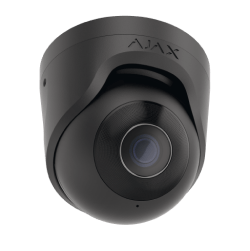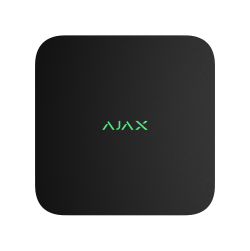
Video surveillance
Wired and wireless cameras, doorbells, and network video recorders
Fast, smart, and secure
Ajax video surveillance devices combine NDAA-compliant hardware, cutting-edge software, and built-in AI to deliver an unrivaled user experience. Enjoy a clear image day or night, smooth and fast navigation empowered by proprietary video transmission technology, and top-level privacy safeguards.
Video surveillance
Wired cameras
View:
Wi-Fi cameras
NVRs
Compatibility
In an Ajax system, you can combine devices of all product categories: Intrusion protection (both Superior and Baseline), Video surveillance, Fire and life safety, or Comfort and automation. Create the system to suit your needs and manage it in a single interface.
Other Ajax product categories
Unlocking the power of video surveillance systems
Security has recently become an increasingly vital concern for homeowners and businesses alike. Whether it's safeguarding a home, protecting assets, or ensuring the safety of loved ones, having a robust security infrastructure in place is paramount. This is where video surveillance systems offer a comprehensive solution to monitor, record, and analyze activity in and around your property. Video surveillance systems have come a long way since their inception. From early closed-circuit television (CCTV) setups to the advanced IP camera systems of today, the evolution of surveillance technology has been nothing short of remarkable. Instead of grainy, low-resolution footage, modern security video cameras offer high-definition video, remote access, and intelligent analytics capabilities.Why is video surveillance important
Beyond simply capturing footage of potential security threats, video security systems deter would-be criminals. The presence of a camera alarm system can significantly reduce the likelihood of break-ins, theft, and vandalism, providing both homeowners and businesses with added peace of mind. Security video cameras' real-time pictures speed up emergency response times. Research shows that using audio verification alone frequently results in false alarms. On the other hand, places that use video verification report a sharp drop in false alarms and better police response times. Additionally, IP camera security system footage can be beneficial evidence of a burglary. Pairing cameras with sensors to improve security for your residence or place of business makes sense.How to choose the right video surveillance system
With plenty of video surveillance camera options available on the market, choosing the right system can be challenging. Factors such as resolution, camera type, storage capacity, and remote access capabilities all play a role in determining which system best suits your needs. It's essential to conduct thorough research and consult with security professionals to ensure that you select the system that meets your requirements. We've prepared a comprehensive guide to help you choose The One from all the surveillance solutions. When you talk to the field professional, the information is familiar, helping you with orientation and understanding of your needs.Surveillance camera types
The first step is determining your needs when choosing a fittable security camera. Do you need an indoor, outdoor, or video doorbell camera alarm system to greet your guests? Each type serves a unique purpose and has features tailored to specific environments.Type of connection
Now, let's talk power. While wired cameras in a video security system offer reliability and ensure uninterrupted surveillance, they often require professional installation. Such IP camera security systems need a power source, which can be provided either through Power over Ethernet (PoE) technology or by running a separate power wire to the camera.Staying connected: Wi-Fi or not
In an era of connectivity, digital IP cameras reign supreme. With intuitive smartphone apps and remote monitoring capabilities, they offer unparalleled convenience. However, analog cameras with local storage remain a viable alternative for those in Wi-Fi dead zones.Recording styles
Choosing between local and cloud storage can be challenging. Local recording keeps your home camera security system data secure on-site, while cloud storage allows you to access your footage from anywhere.- DVR: Typically analog and wired, DVR cameras connect to a hard drive via coaxial cable.
- NVR: These often use Ethernet cables for reliable communication and recording on a networked hard drive.
- Cloud recording is off-site storage via a cloud server, accessible from anywhere with an internet connection, and usually subscription-based video security systems.
- Hybrid solutions: Some CCTV systems combine cloud and local storage, such as cameras with built-in flash drives or NVRs with integrated hard drives, ensuring accessibility and data security.
Finding your surveillance camera shape
Security cameras come in all shapes and sizes, from sleek bullets to stealthy domes. When selecting the perfect form factor, consider your space and surveillance needs. After all, the aesthetics and functionality of video alarm systems matter.- Bullet: Bullet security video cameras guard a room's corners well.
- Dome: Dome cameras are slightly more challenging to install than bullet cameras but offer several advantages. Their placement on ceilings allows for a wider field of view due to their spherical design, making them ideal for monitoring large areas.
- A pan-tilt-zoom camera (PTZ camera): Sometimes, we want to be wider than a camera's field of view, where panning, tilting, and zooming come in. This gives us more freedom to see exactly what we want, and the best cameras can pan all the way around for total coverage.
- Hidden: This one should go without saying; hidden cameras are made to resemble other things, such as pens, teddy bears, or just a little, discreet camera. We advise against installing hidden cameras, as visible cameras can deter would-be burglars.
- Turret or Eyeball Camera: A turret camera, resembling a dome camera, combines the best of both worlds. It allows for flexible positioning at any angle, providing a versatile setup that can be adjusted to various monitoring needs.
Camera alarm system features to look for
Once you've decided which type of video alarm system you want, it's time to look into the device features, asking yourself the following questions:- Power: Is the security camera powered by a plug-in cable or a battery? If it's battery-powered, consider the battery life and whether it is rechargeable or replaceable. For outdoor cameras, check if a solar panel option is available to extend battery life. If the camera is plugged in, determine the length of the power cord and whether the plug is weatherproof or requires an indoor outlet. While seemingly trivial, these details significantly impact the ease of installation and overall functionality of your security camera setup.
- Durability: It's crucial to consider your camera's temperature range and IP rating if you plan to use it outside. Make sure that the camera is compatible with the temperature range in your area, if it is from 0 to 100 degrees Fahrenheit (around -17.78 to 37.78 degrees Celsius). Then, an IP rating is a two-character number that indicates a camera's resistance to solids and liquids, with the first digit representing solids and the second liquids. An outdoor camera with an IP rating of 65, typical for outside cameras, can withstand low-pressure water jets and complete dust sealing, making it suitable for frequent rain and snowfall.
- Video quality: Unlike earlier models with 720p HD resolution, most smart security cameras these days feature 1080p HD resolution. Higher-end cameras feature twice as many pixels and 1080p HD, with 2K or 4K resolution.
- HDR: Taking pictures outside can be challenging because sunlight and shadows distort otherwise sharp images. High dynamic range, or HDR, reduces the majority of glare and shadows from outdoor video, giving it a more lifelike appearance than before.
- Field of view: Field of view indicates how wide the camera's footage is; usually, this number should be at least 120 degrees, with 180 degrees being the mathematical limit. Look for a camera that pans all the way around for a more extensive range.
- Night vision: It's important that a camera can show you what's going on at night and during the day. Night vision comes in two forms: infrared via LED sensors, with black-and-white footage, or color from a bright white spotlight.
- Storage and recording: Storage can be local, typically in a micro-SD card built into the camera or an external hard drive. With local storage, the footage is recorded directly onto the card or hard drive, and cloud, where the footage is automatically uploaded onto a cloud server, which may or may not require a paid subscription. We prefer hybrid cameras with both cloud and local storage; that way, if one method fails, you have a backup.
- Artificial Intelligence: Most smart security cameras can recognize motion, alerting users when they detect it. However, this can lead to a lot of false and unnecessary notifications from things like animals, cars, and other inanimate moving objects. To combat this, look for cameras with advanced AI features like person detection, which can distinguish between people and objects. Additionally, some cameras can differentiate between objects, such as pets or vehicles, and organize footage accordingly. These cameras tag the footage by the type of object detected, allowing for a more efficient review of recorded video sequences.
- Activity zones: Activity zones make notifications more specific, ignoring areas we set the camera to ignore and only focusing where the monitoring is needed.
- Installation: A professional video alarm system is crucial for optimal security. Here's how professional installation happens: a certified technician will come to your home, mount the camera in the most strategic locations, connect it to your network, and configure the system to ensure everything is working correctly. This ensures your home video surveillance system is set up securely and efficiently. Additionally, a professional will create a custom project tailored to your configuration, ensuring everything is top-of-the-line and meets your security needs.
- App: A user-friendly app is important for live streaming footage, controlling the smart camera remotely, and receiving timely notifications. Depending on your mobile device's make, it's best to make sure your security systems app has good ratings on either the iOS or Android store.
- Privacy: It's no secret that Internet of Things (IoT) devices, including security cameras, are sometimes up to snuff when it comes to security. Some simple Wi-Fi cameras, especially those with subpar software, can be particularly vulnerable to breaches, making them easy targets for hackers and spies. This highlights the importance of choosing reliable, high-quality security cameras, especially for a home camera security system.
- Two-factor authentication: This adds an extra layer of security by requiring a passcode in addition to the regular username and password to access camera accounts. Extra points if the app supports fingerprint or face ID, which are part of multi-factor authentication.
- Encryption: When choosing a security camera, ensure it offers strong encryption to protect your footage from unauthorized access. Look for cameras that reliably safeguard your privacy and keep your data secure at all times.
- History of breaches: To stay safe, consider researching if the company has experienced any security breaches. Unfortunately, this is a common risk with any Internet-connected device, from smart security cameras to other smart home devices.










